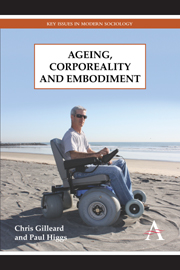Book contents
- Frontmatter
- Contents
- Introduction
- Chapter 1 Identity, Embodiment and the Somatic Turn in the Social Sciences
- Chapter 2 Corporeality, Embodiment and the ‘New Ageing’
- Chapter 3 Gender, Ageing and Embodiment
- Chapter 4 Age and the Racialised Body
- Chapter 5 Disability, Ageing and Identity
- Chapter 6 Sexuality, Ageing and Identity
- Chapter 7 Sex and Ageing
- Chapter 8 Cosmetics, Clothing and Fashionable Ageing
- Chapter 9 Fitness, Exercise and the Ageing Body
- Chapter 10 Ageing and Aspirational Medicine
- Conclusions: Ageing, Forever Embodied
- References
- Index
- ADVANCE PRAISE
Chapter 5 - Disability, Ageing and Identity
Published online by Cambridge University Press: 05 July 2013
- Frontmatter
- Contents
- Introduction
- Chapter 1 Identity, Embodiment and the Somatic Turn in the Social Sciences
- Chapter 2 Corporeality, Embodiment and the ‘New Ageing’
- Chapter 3 Gender, Ageing and Embodiment
- Chapter 4 Age and the Racialised Body
- Chapter 5 Disability, Ageing and Identity
- Chapter 6 Sexuality, Ageing and Identity
- Chapter 7 Sex and Ageing
- Chapter 8 Cosmetics, Clothing and Fashionable Ageing
- Chapter 9 Fitness, Exercise and the Ageing Body
- Chapter 10 Ageing and Aspirational Medicine
- Conclusions: Ageing, Forever Embodied
- References
- Index
- ADVANCE PRAISE
Summary
Of all the various forms of embodied identity, disability might seem to have the most in common with the new ageing. There seem obvious parallels between the disability movement's rejection of the idea of physical limitation constituting the basis for their embodied identity and the rejection within the cultures of the third age of corporeal weakness as a marker for later life. Yet such a coalition of interests has proved hard to realise, despite numerous calls for an alliance between older people's organisations and disability rights activists. This may be because both approaches have tended to pass over the subjective embodiment of both older people's and disabled people's lives, preferring instead to focus on issues of citizenship and civic rights. Another factor is the potential unease that such a coalition of interests might entail by implicitly acknowledging the body as a common ‘flaw’. Addressing the body and its limitations might prove too uncomfortable, as it risks both groups being ‘recaptured’ by the modern institutions of health and social care from which they are still struggling to escape. However, an even more important factor in our view is the historical setting of the disability movement which emerged as one of the later ‘new social movements’ from the youth countercultures of the 1960s (Campbell and Oliver 1996, 46).
- Type
- Chapter
- Information
- Ageing, Corporeality and Embodiment , pp. 69 - 86Publisher: Anthem PressPrint publication year: 2013



